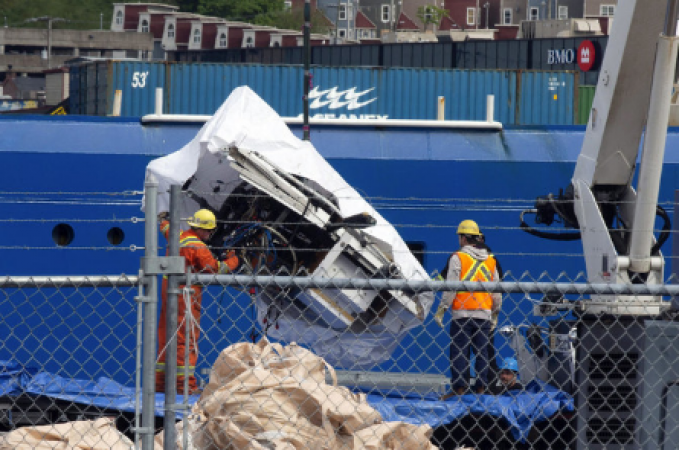
Portland: After a fatal implosion during its voyage to the Titanic wreck last week captured the attention of the entire world, debris from the Titan submersible has been brought back to land.
The investigation into why the submersible imploded, killing all five people on board, relies heavily on the debris being brought back to port in St. John's, Newfoundland and Labrador. On Wednesday, twisted pieces of the 22-foot submersible were unloaded at a pier belonging to the Canadian Coast Guard.
The Canadian ship Horizon Arctic carried a remotely operated vehicle, or ROV, to look for submersible parts on the seafloor close to the Titanic wreck. The ROV's owner, Pelagic Research Services, a business with locations in Massachusetts and New York, announced on Wednesday that it has finished
Also Read: US Economy's Momentum Slows: GDP Growth Dips to 1.5%, Predicted Further Decline in Q2
The team from Pelagic Research Services is "still on mission" and is unable to comment on the ongoing Titan investigation, which is being conducted by a number of American and Canadian government agencies, according to company spokesperson Jeff Mahoney.
They have been working nonstop for the past ten days despite the operation's physical and mental demands, and they are eager to complete the mission and get back to their loved ones, Mahoney said.
The Coast Guard reported last week that debris from the Titan was found on the ocean floor 1,600 feet (488 metres) from the Titanic and at a depth of about 12,500 feet (3,810 metres). The submersible imploded during its descent on June 18, and the Coast Guard is currently overseeing the investigation into why. On June 22, authorities declared that the submersible had imploded and that all five aboard had perished.
Also Read: World Bank Sounds Alarm: Global Growth Forecast Slashed to 2.9%, 'Severe' Recession Risks Loom
A Marine Board of Investigation into the implosion has been established by the Coast Guard. That is the Coast's most thorough level of investigation.
Analysing the physical components of debris recovered during the search, according to one of the experts the Coast Guard consulted with, may yield crucial hints about what happened to the Titan. Additionally, according to Carl Hartsfield of the Woods Hole Oceanographic Institution, there might be electronic data.
"Undoubtedly, data is recorded by every instrument on a deep sea vehicle. They disregard data. So, the obvious question is: Is there any information? And the truth is, I have no idea what the answer is," he admitted on Monday.
Requests for comment from Horizon Arctic representatives went unanswered.
On Wednesday, representatives of the Coast Guard chose not to comment on the investigation or the retrieval of the debris. Although Coast Guard officials had earlier stated that they were taking precautions in case they came across human remains during the investigation, no bodies have been found.
Along with two prominent Pakistani family members, Shahzada Dawood and his son Suleman Dawood, British adventurer Hamish Harding, and Titanic expert Paul-Henri Nargeolet, Ocean Gate CEO and pilot Stockton Rush also perished in the implosion.
The investigation is being conducted by the National Transportation Safety Board and the Transportation Safety Board of Canada, both of whose representatives declined to comment. The Titan submersible's loss has been classified as a "major marine casualty" by the Coast Guard, according to the National Transportation Safety Board, and the Coast Guard will oversee the investigation.
Liam MacDonald, a spokesman for the Transportation Safety Board of Canada, said that because the investigation is still ongoing, "we are unable to provide any additional information at this time."
Any investigative reports from the disaster will be submitted for review, according to a spokesman for the International Maritime Organisation, the U.N.'s maritime agency. The IMO's member states can also suggest modifications, like stricter rules for submersibles.
The International Maritime Organisation (IMO) currently has voluntary safety standards for tourist submersibles that include, among other things, requirements that they be inspected, have emergency response plans, and have a certified pilot on board. The IMO's next Maritime Safety Committee, which convenes in May 2024, is likely to be the last opportunity for the organisation to consider any safety proposals.
Also Read: Surging Support: US Receives 20-Year High in Israel, Reveals Poll
Although the Titan's owner and operator, OceanGate Expeditions, is based in the United States, the submersible was actually registered in the Bahamas. When the Titan was discovered, the OceanGate business in Everett, Washington, shut down. The Polar Prince, the Titan's mother ship, was a Canadian vessel.
Each passenger paid the operator $250,000 to take part in the trip. The safety of private undersea exploration operations has come under scrutiny following the Titan's explosion. The investigation will also be used by the Coast Guard to enhance submersible safety.